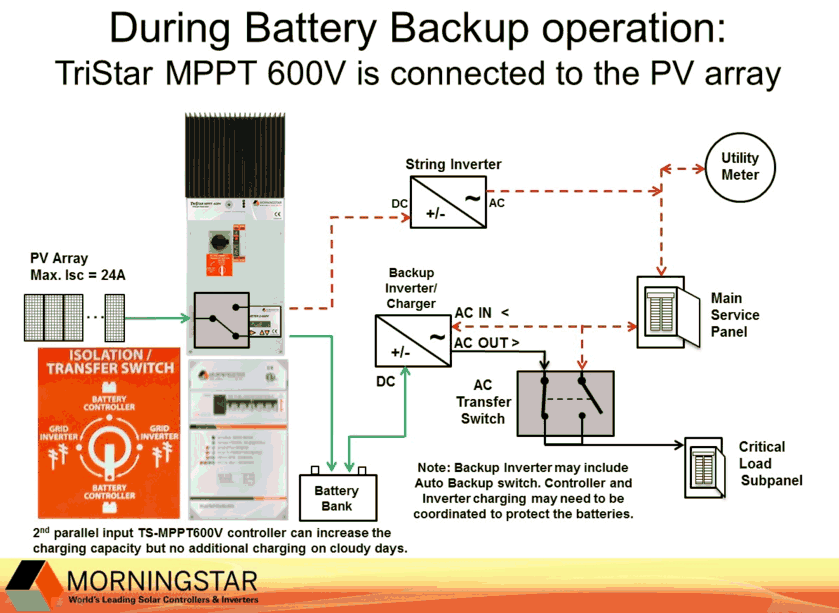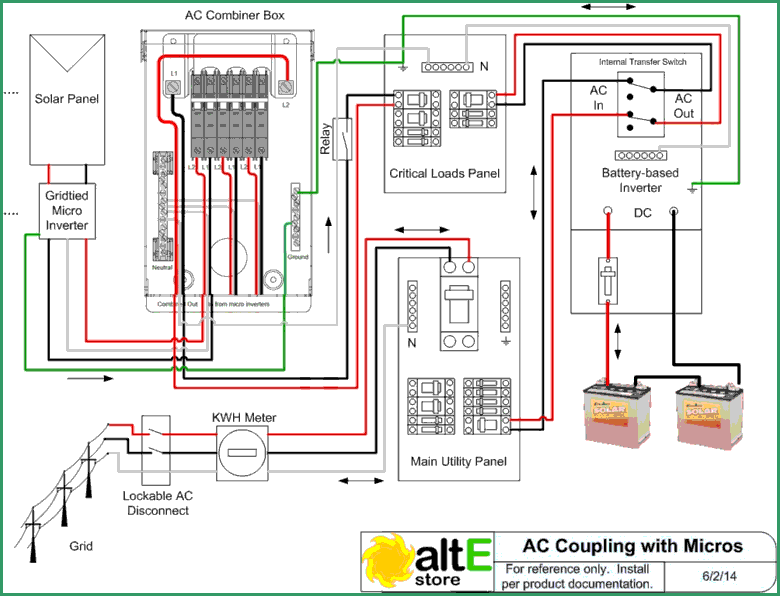
DC Coupling as a New Alternative to AC Coupling
Three years ago, we wrote a blog about adding deep cycle batteries to your existing grid tie solar system with AC Coupling. It was the best way at the time to convert a grid tie solar system to a battery backup system, by back-feeding the solar power through a battery based inverter. Since it was installing the system in a way that the inverter wasn’t initially designed to be used, it did have some limitations, such as requiring the battery based inverter and the battery bank be big enough to handle the whole grid tie system. This can result in a bigger, and more expensive battery backup than you need or want. This issue can be addressed in micro inverter systems, where only some of the micro inverter are connected to the AC Coupling system. But until recently, there wasn’t an easy way for string inverters, where all of the solar panels are wired into the one central inverter, to have a small battery backup solution. But now there is, with DC Coupling.
What Is DC Coupling?
Schneider Electric and Morningstar Corporation now have 600V solar charge controllers available. The advent of these controllers controllers allow you to take an entire string of solar panels during a power grid outage and switch them from the input of the grid tie solar inverter to the input of the high voltage solar charge controller instead. Using a solar charge controller to charge a battery bank is how charging batteries with solar has been done for decades. The high voltage charge controllers now make it possible to redirect from the grid tie inverter without having to restring your system. Using a DC transfer switch, such as the one built into the Morningstar TriStar MPPT 600V Charge Controller with Disconnect and Transfer Switch, when the grid goes out and the grid tie inverter turns off, as it is required to, you simply turn a switch, and the solar panels will keep your battery bank charged. This is known as DC Coupling.

Diagram of a DC Coupled System for battery back of solar grid tied system. The Morningstar MPPT 600V solar charge controller is used in this example. Courtesy of Morningstar Solar
Adding Batteries, Inverter/Charger to Your Grid Tie Solar System
Just like with the AC Coupling systems, you need to add a battery based inverter/charger to the system to convert the power from the battery to the AC power to go to your Critical Loads Panel to power your fridge, lights, well, whatever you deemed critical. When the grid is up, the deep cycle batteries are charged and kept topped up with the AC Charging functionality of the inverter/charger, this is also the same as with AC Coupling.
But unlike an AC Coupled system, with DC Coupling, using a solar charge controller instead of back-feeding through the inverter/charger allows you to charge your battery bank with 3-stage charging from the charge controller, rather than an all or nothing from the inverter. The controlled charging from the charge controller will result in healthier, longer lasting batteries. It also gives you a way to limit the number of solar panels going into the battery bank to one or two strings. This allows you to have a small battery bank and inverter, as you can restrict the amount of power going into the battery bank through the charge controller, and can control the amount of current being used to charge it.
With AC Coupling, if you have a 6,000W inverter backfeeding through an inverter/charger, you need to have an inverter/charger that is at least 7,500W, and a 48V battery bank that is around 1200Ah to keep the charge rate at under C-10 to maintain a healthy battery bank. If you have small backup needs, this can be too large of a system, and cost prohibitive. With DC Coupling, with the same 6,000W grid tie solar system, you can choose to take only half of the panels, one string of 12 in series, and charge a 600Ah or smaller battery bank. The only restriction on the size of the battery bank and the inverter/charger is dictated by your critical loads. How much backup power do your loads need, not how much power does your solar system require you to have.
Choosing the Right Coupling System for Your Solar System
AC Coupling is still your best solution for use with microinverters and DC optimizer/string inverters like the SolarEdge system, as they don’t have 600V DC strings coming to the centralized inverter. But any grid tie solar system with string inverters that have up to 600VDC in series going into the inverter are a great candidate for adding the safety and comfort of a battery backup with DC Coupling.
For more info on both solutions, watch our videos on DC Coupling with Morningstar and AC Coupling. The altE Store has created some pre-designed AC and DC Coupled Solar System kits for you as a starting point or give us a call and we’ll help you design one.


That depends entirely on what you need to backup, and how you size your battery bank. Create a loads list of what you want to backup, and for how long. You can go to our loads list calculator to do that. https://www.altestore.com/store/calculators/load_calculator/. Once you know how much power you need to store, you can go to the off grid calculator to see what size battery bank you need.https://www.altestore.com/store/calculators/off_grid_calculator/ Or give us a call with your loads list and we can take it from there.
can anybody tell me how many hours of back up can we expect from this coupling?